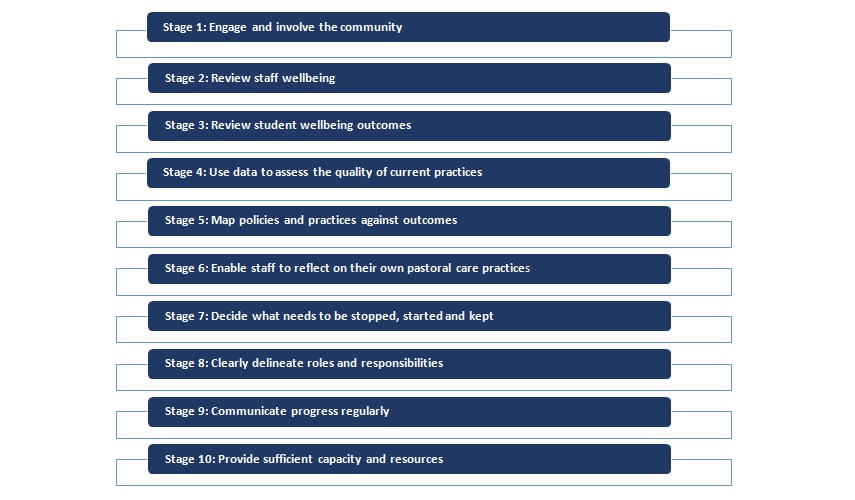Pastoral care is not merely a complementary practice; it is policy and practices fully integrated throughout the teaching and learning and structural organisation of a school to effectively meet the personal, social (wellbeing) and academic needs of students and staff.
The health and wellbeing of students is increasingly being attributed to school conditions, school relationships, means of fulfilment, and health status (Konu, Alanen, Lintonen & Rimpela, 2002).
Subsequently, pastoral care has taken on a more inclusive function, one that is inextricably linked with teaching and learning and the structural organisation of the school - promoting students' personal and social development and fostering positive attitudes. This is done through the quality of teaching and learning; through the nature of relationships amongst students, teachers and adults other than teachers; through arrangements for monitoring students’ overall progress (academic, personal and social); through specific pastoral and support systems; and through extra-curricular activities and the school’s ethos (Her Majesty’s Inspectors of Schools, 1989).
From this perspective, pastoral care can assist students to develop positive self-esteem, healthy risk taking, goal setting and negotiation, thus enhancing their strengths and other protective factors contributing to their resiliency as well as developing a sense of social cohesion that together can improve their overall health and wellbeing (Nadge, 2005 and Doll & Lyon, 1998).
Quality pastoral care focuses on the whole student (personal, social, and academic) and it engages all members of the school community as providers of pastoral care. It actively involves the community in consistent, comprehensive, multi-level activities which incorporate whole-school approaches, class or other group approaches, individual programs (early intervention), and casework.
Regular reviews of a school’s pastoral care policies and practices help the school community to systematically assess their school’s pastoral care resources, strengths, needs, threats and opportunities. This information can help schools map their pastoral care resources, activities and services against their pastoral care and academic outcomes to objectively determine where pastoral care activity can be reduced, redirected and improved.
The following 10-point action plan provides a snapshot of a process that will help schools systematically review their pastoral care program.

Image: Donna Cross and Leanne Lester.
Stage 1: Engage and involve the community
Engaging the whole school community (staff, students and parents) is a key strategy to promote pastoral care in schools. Clemett and Pearce (1989) state that pastoral care is effective ‘when everyone in the school community knows, and feels secure in the knowledge that as valued members of that community, they can participate in giving and receiving encouragement, guidance and support’. Policies and programmes need to provide opportunities for staff, students and parents to be involved in making decisions, being heard and making a contribution to the community (Bernard, 1996).
Stage 2: Review staff wellbeing
A review of staff wellbeing will enable the assessment of the appropriateness and effectiveness of current systems, structures and services in the school that provide support in this area. Staff wellbeing can be enhanced through professional learning, celebrating staff strengths and achievements, policies to prevent and reduce staff stress, encouragement to collaborate with other staff, and access to professional advice (Cefai & Cavioni, 2014), (Cross & Lester, 2014), (Howieson & Semple, 2000). If staff wellbeing is cared for, then staff are more able to care for student wellbeing.
Stage 3: Review student wellbeing outcomes
According to Cross, Lester and Barnes (2014), students present a socially relevant and accurate depiction of the quality of pastoral care provided in their school, hence their involvement in the review process is essential to guide school improvement. The review could assess student wellbeing using the four critical components of pastoral care: promotion of health and wellbeing; resilience; academic care; and social capital within the school community (Nadge, 2005). A variety of standardised reliable and valid measures can be used by schools to conduct this assessment.
Stage 4: Use data to assess the quality of current practices
Schools have access to many different sources of data: academic, behavioural and attendance as well as student, parent and staff satisfaction surveys. These data can be used to measure the predictors of or the effectiveness of current pastoral care practices. Quantitative and qualitative data can be collected from all levels in the school - the whole-school level (senior executive team), from house or year groups, as well as tutors, students and parents and carers.
Stage 5: Map policies and practices against outcomes
Pastoral care policies and practices can be mapped against the schools’ strategic plan and key pastoral care outcomes in order to identify existing overlaps and gaps. This stage also assesses the appropriateness and effectiveness of current systems, practices, policies and services, and the extent to which these achieve the identified wellbeing outcomes.
Stage 6: Enable staff to reflect on their own pastoral care practices
Teachers and other school staff need to clarify their understanding of their pastoral care role, and how their own actions, and their relationships with students, can enhance or harm the wellbeing of students (Best, 2002). This ‘academic care’ is influenced by: personal qualities of teachers and their relationships with students; the curriculum and its ability to promote meaningful participation and positive learning experiences; the school’s organisational structure and its ability to offer safety, support, trust, guidance and challenge; and links with the broader community.
Stage 7: Decide what needs to be stopped, started and kept
Determination by staff of what is currently working well, what’s not working well, what’s missing and what’s promising in the school is essential, especially given the limited resources for pastoral care. This decision making may consider policies and practices related to the five key pastoral care school-level tasks: proactive, preventative pastoral care; developmental pastoral teaching and learning; the supportive/collaborative environment; reactive casework; and the management and administration of pastoral care (Department of Education, 2001).
Stage 8: Clearly delineate roles and responsibilities
Careful delineation of the roles and responsibilities of all members of the school community to promote a safe and supportive environment needs to be explicit, clearly understood by all and disseminated widely and often. This understanding reduces the pastoral care burden often experienced by pastoral leaders within the school, and encourages students, staff and families to recognise how much they can contribute to a positive, safe and supportive school culture.
Stage 9: Communicate progress regularly
Present the purpose, process, major findings and recommendations from a review to the staff and other members of the school community. To ensure ongoing engagement, support for and sustainability of pastoral care within the whole-school community, community members need to be updated regularly on the pastoral care activities and processes being implemented.
Stage 10: Provide sufficient capacity and resources
Sufficient staff capacity and resources are needed to successfully align and integrate the outcomes of a pastoral care review into the school’s vision and strategic plan. A pastoral care ‘master plan’ can be used to guide and monitor the ongoing implementation of recommendations to the school community.
References
Benard, B. (1996). From research to practice: the foundations of the resiliency paradigm. Resiliency in action, 1(1): 1-6.
Best, R. (2002) Pastoral care and personal social education. A review of UK research undertaken for the British Educational Research Association. Cited 2005, 1 December. Retrieved from http://www.bera.ac.uk/pdfs/BEST-PastoralCare&PSE.pdf
Cefai, C., Cavioni, V. (2014). Social and Emotional Education in Primary School: Integrating Theory and Research Into Practice. Springer.
Clemett, A.J. and Pearce, J.S. (1989). The evaluation of pastoral care. Oxford: Blackwell.
Cross, D., Lester, L. (2014). The Wellbeing of Teachers. In submission.
Cross, D., Lester, L., Barnes, A. (2014). Evaluating pastoral care. Independence, 30(1): 46-51.
Department of Education (2001). Pathways to Health and Wellbeing In Schools: A Focus Paper. Cited 2005, 20 December. Retrieved from http://www.health.wa.gov.au/mentalhealth/symposium/ChildYouth/pdfs/Pathways_to_health_wellbeing_in_schools.pdf
Doll B., Lyon M.A. (1998). Risk and resilience: Implications for the delivery of educational and mental health services in schools. School Psychology Review, 27(3): 348.
Her Majesty's Inspectors of Schools (1989). Pastoral care in secondary schools. An inspection of some aspects of pastoral care in 1987-88. London: Department of Education and Science.
Howieson, C., Semple, S. (2000). The evaluation of guidance: Listening to pupils' views. British Journal of Guidance & Counselling, 28(3): 373.
Konu A., Alanen E., Lintonen T., Rimpela M. (2002). Factor structure of the School Well-being Model. Health Education Research, 17(6): 732.
Ministerial Council on Education Employment Training and Youth Affairs (2003). National safe schools framework. Cited 2005 9 December. Retrieved from http://www.mceetya.edu.au/pdf/natsafeschools.pdf
Nadge A. (2005). Academic care: building resilience, building futures. Pastoral Care, 23(1): 28-33.
Nadge, A. (2005). Academic care: from research to reality. Independent Education. 35(2): 30-32.
Does your school undertake a regular pastoral care review?
What changes have you made to the school as a result of the findings?



